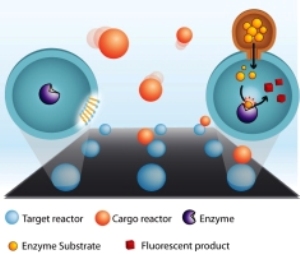University of Copenhagen researchers have achieved a major milestone in that they have been able to handle reactions at extremely small volumes, i.e., 10-19 L. This is nearly billion times smaller than anyone has ever handled previously.
It is intriguing that they have been able to handle these reactions simultaneously for nearly millions of samples on a single chip. By working with such tiny volumes, it will be feasible to formulate drugs in a quicker and greener way ensuring less expensive medicines for customers.
 The ultra small nanoreactors have walls made of lipids
The ultra small nanoreactors have walls made of lipids
The Department of Neuroscience and Pharmacology at the University of Copenhagen and the Bionano Group at the Nano-Science Center have been striving for the past five years to characterize and examine how molecules react and how they join together to form larger molecules and these findings can be used to develop new drugs.
These tiny nanoreactors have lipid walls. Volumes as small as 10-19 L were transmitted between nanoreactors enabling the contents to react chemically and form a mixture. Professor Dimitrios Stamou anticipates that the industry will welcome this technology as it will make drug investigation more rapid, cost-effective and green.
The reason behind being able to attain such small scales is that the research team has been working on the principle of self-assembly. According to this principle, molecules can assemble themselves together without external control to form a common structure.
Stamou added that they were able to study the reaction of specific self-assembling systems with a range of substances and this knowledge has been utilized to formulate the technique. Self-assembling systems comprise biological materials like fat that do not affect the environment unlike materials like silicon, plastics and metals. This ensures that this technique is green and eco-friendly.